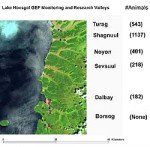J. Tsogtbaatar1, Clyde E. Goulden2, Bazartseren Boldgiv3
1 Geoecology Institute, Mongolian Academy of Sciences, Ulaanbaatar 211238, Mongolia
2 Institute for Mongolian Biodiversity and Ecological Studies, Academy of Natural
Sciences, 1900 Benjamin Franklin Pkwy. Philadelphia, PA 19103
3 Department of Biology, University of Pennsylvania, Philadelphia, PA 19104
Mongolia lays on a plateau in eastern Asia with an average altitude of 1300 meters, bordered by the Altai and Sayan Mountains in the west and north, the Gobi in the south, and broad steppe grasslands in the east (Figure 1). It covers an area about equal in size to Alaska, and with a population of only 2.5 million people. The climate is harsh with high summer temperatures and very cold winters (-40 to -50° C in the winter) and a precipitation gradient from south to north ranging from 10-20 mms annual rainfall in the Gobi, to 250 to 350 mms in the northern mountain regions around Lake Hövsgöl and in the Hentii. The northern region marks the southern boundary of the Siberian taiga and of continuous permafrost. A belt of steppe crosses the mid-region from west to east, the major grazing lands of nomadic herders. The nomads live in portable tent-like “gers” that can be dismantled and conveniently transported on camel or yak-drawn carts when the herders move their animals to seasonal feeding grounds.
The MLTER was approved by the Government of Mongolia in 1997. It is sponsored by the Mongolian Academy of Sciences (MAS), and is directed by a Steering Committee consisting of representatives from the Academy, major universities, and ministries. The purpose of the MLTER is to provide objective scientific information for achieving the goals of both economic growth and the protection objectives of Mongolia’s Biodiversity Action Plan. It also supports the training of young Mongolian scientists in biodiversity and ecological research. The MAS hosted the fourth meeting of the East Asian ILTER at Lake Hövsgöl. Some of the presentations can be found at http://www.acnatsci.org/~goulden/mlter_2001_meeting.htm.
Because of its geographic isolation and small population, large areas of the countryside remain almost pristine, and have remnant populations of large mammals (e.g., Bactrian Camel (Camelus bactrianus ferus), Saiga (Saiga tatarica), Snow Leopard (Uncia uncia), Desert Bear (Ursus arctos gobiensis), Musk Deer (Moschus moschiferus), and a large migrating population of the Mongolian Gazelle (Procapra gutturosa, one of the remaining large migrating populations), as well as other species that once roamed throughout the vast Asian steppe.
The first site of the MLTER was designated at Lake Hövsgöl, a tectonic “sister” lake and located southwest of Baikal. Other sites with active programs that should soon be designated as ILTER sites occur in the Gobi, eastern grassland, and in the Hentii Mountains. The primary objectives of research at the Hövsgöl MLTER include defining biodiversity and ecosystem impacts from nomadic pastoralist activity, increased incidence of fires in taiga forest and interactions with long-term climate change, including the thaw of permafrost. Hövsgöl is very appropriate for such studies because its location at the boundary of the taiga forest and steppe make it an area of substantial future change. Its north south alignment and series of parallel east to west stream valleys entering the lake allow studies of climate change and impacts on permafrost (Figure 3). Pasture use is greatest near towns where the herdsmen congregate to sell products.
The six study valleys along the eastern side of the lake south of the town of Hanh have a gradient of livestock use ranging from intense in the northern valleys, to low use or an absence of grazing in the southern valleys.
Specific research areas of monitoring and research include: climate and hydrology, active layer depth and temperature of permafrost associated with plant cover, forest regeneration, steppe ecology, plant decomposition, terrestrial insects including following a gypsy moth eruption, stream biodiversity and water quality, ornithology, small mammals, livestock pasture use and observation of activities of the nomad families.
A GIS is being developed, and we hope to incorporate community and ecosystem level modeling soon.
Research activities at the Hövsgöl MLTER site have developed in conjunction with scientists from international institutions who are working within teams consisting of a senior Mongolian scientist, a young Mongolian researcher in training, an international scientist and the International Consultant (Figure 3). Biostatistics and experimental design have been an important part of the training.
The Mongolian Academy would like to encourage cross-site comparison studies with other LTER and ILTER sites around the world, especially in steppe studies, biogeochemistry, forest studies, climate and ecosystem modeling. Please see the Web site, http://www.acnatsci.org/~goulden.

 Enlarge this image
Enlarge this image

